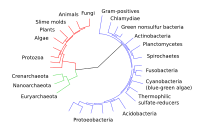
Photo from wikipedia
Ecological opportunities can be provided to organisms that cross stringent biogeographic barriers towards environments with new ecological niches. Wallace's and Lyddeker's lines are arguably the most famous biogeographic barriers, separating… Click to show full abstract
Ecological opportunities can be provided to organisms that cross stringent biogeographic barriers towards environments with new ecological niches. Wallace's and Lyddeker's lines are arguably the most famous biogeographic barriers, separating the Asian and Australo-Papuan biotas. One of the most ecomorphologically diverse groups of reptiles, the pythons, is distributed across these lines, and are remarkably more diverse in phenotype and ecology east of Wallace's line in Australo-Papua. We used an anchored hybrid enrichment approach, with near complete taxon sampling, to extract mitochondrial genomes and 376 nuclear loci to resolve and date their phylogenetic history. Biogeographic reconstruction demonstrates that they originated in Asia around 38-45 Ma and then invaded Australo-Papua around 23 Ma. Australo-Papuan pythons display a sizeable expansion in morphological space, with shifts towards numerous new adaptive optima in head and body shape, coupled with the evolution of new micro-habitat preferences. We provide an updated taxonomy of pythons and our study also demonstrates how ecological opportunity following colonization of novel environments can promote morphological diversification in a formerly ecomorphologically conservative group.
Journal Title: Systematic biology
Year Published: 2020
Link to full text (if available)
Share on Social Media: Sign Up to like & get
recommendations!